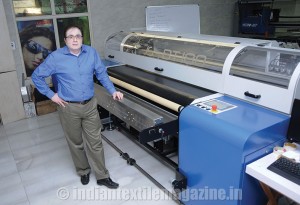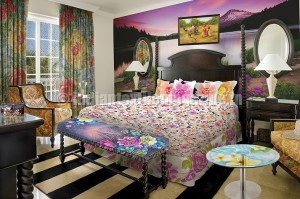By Arun Rao
The Ahmedabad-based Arrow-Digital has been in business since last 60 years with a rich background in printing and packaging. Considered a pioneer in digital printing, it introduced the first bill board printers in India, the CAT/CAD signage machines and digital cutting machines.

Ten years ago, Arrow explored the dye sublimation textile printing business prospects. But, according to Mr. Sameer Patel, Managing Director of Arrow-Digital, it was too premature for India, and after spending a big amount on R&D, the company withdrew from the business.
About three years ago, Arrow gave a re-look at the digital textile printing machine business and saw that there were quite a few Chinese and cheap digital printer machines installed in India. It started discussing with the Italian developer of digital textile printers, FTex, and the Japanese Seiko to develop machines which would meet the requirements of the Indian textile fabric printing industry.
Arrow-Digital has set up what it calls a one-of-its-kind digital textile printing R&D and demonstration centre in Ahmedabad. It has installed an FTex digital textile printer, a laboratory, related software, etc., where training can be imparted to employees of textile companies buying the printers.
Mr. Sameer Patel tells The Textile Magazine: “Showing pictures and videos is not going to help a buyer make up his mind to invest in a digital printer; so the demonstration centre of the actual technology has been set up for potential buyers of digital printers to explore the full potential of the technology by first printing fabric samples and get a first-hand feel of the fabric”.
He adds: “Potential digital printer buyers also get an opportunity to do R&D with different fabrics, at the demonstration centre, without any cost or expense to the customer, then go and check out the feasibility of the product in the market. This helps them take an informed decision before finally deciding to buy the machine.”
After being fully convinced of the potential of the printer, the buyer places the order. During the period between the order placement and the machine delivery, Arrow-Digital trains the buyer’s employees on various facets of the machine, which, according to Mr. Sameer Patel, ensures that the machine is up and running from the day it is installed.
“Even a considerable period of time after the machine installation, we encourage the buyer to do R&D on various other fabrics at the demonstration centre, so that regular production on his machine is not disrupted,” he adds.
Arrow-Digital prides itself on the after-sales-support it offers to its customers. However, it also pushes on self-support or self-service. While undergoing training, these operators are also fully equipped to take care of small issues that impact a running machine at the buyer’s end. All this enables the Arrow service engineers to take care of major issues, if any.
According to Mr. Sameer Patel, FTex digital textile printers are so built that they can be remotely controlled through the internet. More than 25 company engineers are located across major cities in India, and a service call is addressed in less than 24 hours.
Ftex is owned by Marco Fontana, who used to work earlier at a digital printing machine producer and has extensive knowledge of the industry, while Seiko supplies the crucial heads and major electronic items which go into the making of the FTex printer.
FTex offers machines in widths of 1.8 metres, 2.4 metres and 3.2 metres and can print in eight colours. It also offers machines in 8 and 16 heads variations, and with the Seiko head, the robust and sturdy FTex printer can operate pretty well with a variety of inks and pigments.
Mr. Patel explains by saying that the fluids that go through the head have to sustain and should also be flushable. If the head does not have a good velocity of dot, then one needs to have a head close to the fabric. At the same time, the head remaining too close to the fabric tends to clog or mist.
For this very reason, in the FTex technology there is considerable gap between the head and the fabric, since the fabric always tends to be dirty. As the inkjet concept works on negative pressure, the head sucks up dust, resulting in the heads clogging very fast.
Commenting on the machine speed, he says gaining more saturation and higher resolutions means more passes of the head, which translates into lower speeds of the machine. While the FTex printer can be run at good resolutions and derive good saturation at higher speeds, so the FTex with a single pass of the head offers better resolution than a competitor’s machine, which would need 3-4 passes to offer the same resolution.
FTex machines deliver productivity of 50-75 metres per hour, with an eight-head machine, and if one doubles the number of heads, the speed can be doubled. Ftex is one of the few digital textile printing machine manufacturers globally capable of customising its machines as per the the customer requirements.
Revealing the USP of FTex, Mr. Sameer Patel notes that other than customisation, whereby a customer can order the machine in the configurations he desires, the FTex is also designed in such a way that in the future, Arrow-Digital can have the printers assembled in India and also customise it as per the requirements of the customer, which can reduce delivery period to just a week from the two months now.
“Similarly, if a customer aims at higher production, he just needs to upgrade the existing FTex machines from 8 to 16 heads resulting in higher speeds and also higher production. All this eliminates the need to invest in another machine,” he observes.
“The textile market in India is ready to take off and, with the ‘Make in India’ program initiated by Prime Minister Narendra Modi, demand for digital textile printers will also boom. Arrow-Digital, on its part, is fully prepared to take advantage of the same,” Mr. Patel signs off by saying.
